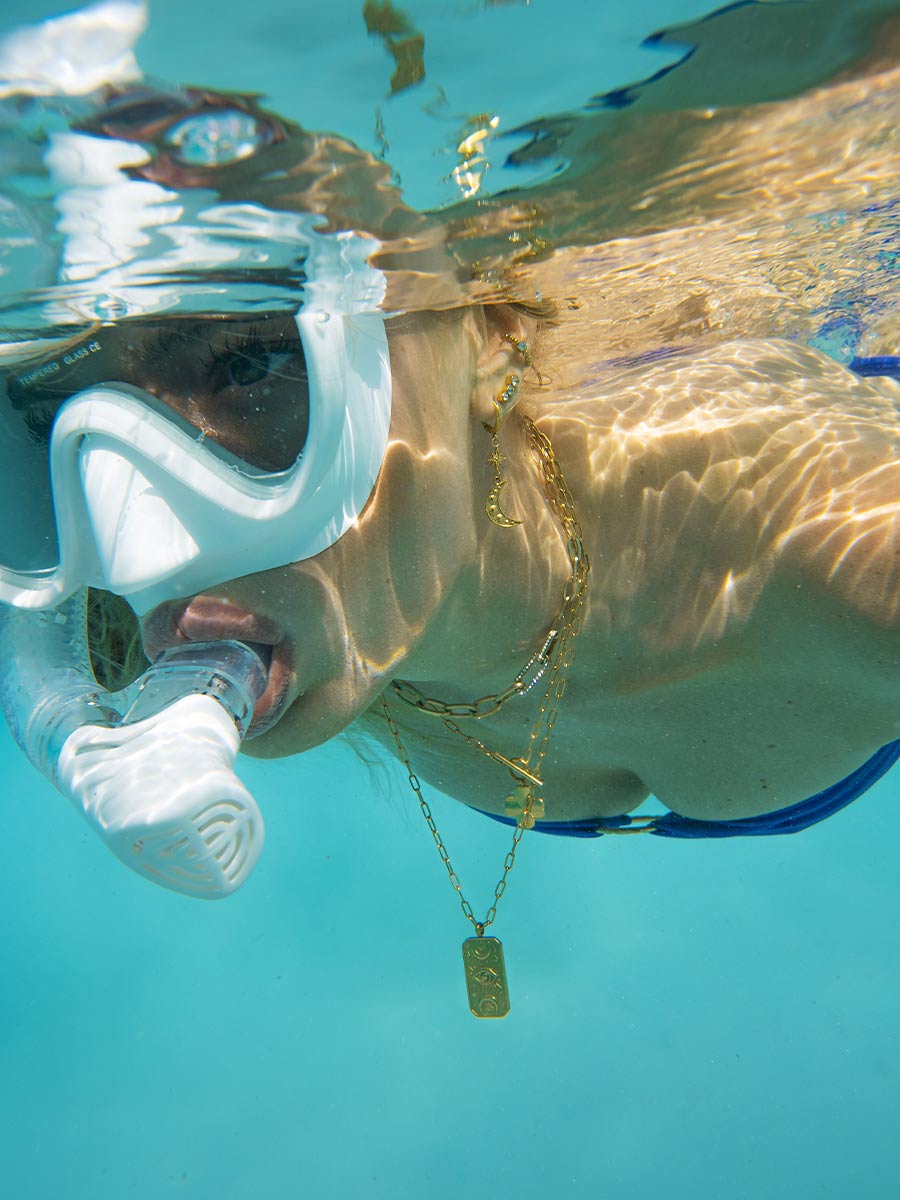
Our jewellery materials - waterproof & allergy-friendly
ICRUSH jewellery stands for durability and high quality. The jewellery materials we use are not only allergy-friendly, but also retain their colour even when in regular contact with water.
Most of our jewellery is made of 316L stainless steel, also called surgical steel, and is 18-carat gold-plated. In addition to surgical steel, we also have jewellery made of 925 sterling silver. Here too, the jewellery is 18-carat gold-plated.
Find out what makes our necklaces, rings, bracelets and earrings waterproof and how you can protect your ICRUSH jewellery from tarnishing and discolouring.
What makes ICRUSH jewellery waterproof?
316L stainless steel is a very durable and resilient material that is well suited to the manufacture of jewellery. Due to its hypoallergenic properties, it has been used in surgery for a long time. As it does not cause allergies, stainless steel is also particularly suitable for ear jewellery and piercings. Stainless steel is also waterproof, i.e. it does not lose its colour or tarnish even after regular contact with water. Jewellery made of stainless steel can therefore be worn in the shower without hesitation. The same applies to gold-plated stainless steel. Since it is a very strong and robust material that is gold-plated by ion plating, the gold-plating adheres very well to the base material. This means that gold-plated stainless steel jewellery does not tarnish, the gold-plating does not wear off over time, but remains permanently intense gold.
925 sterling silver is the higher quality material compared to 316L stainless steel, but also the more delicate. Sterling silver has been used in jewellery making for a very long time because it has a beautiful radiant shine. Silver can tarnish slightly over time, this is a normal reaction of the material to external environmental influences. Our sterling silver jewellery is rhodium plated, which means that it has an additional coating that delays the tarnishing of the material. With regular contact with water, even rhodium-plated silver jewellery can tarnish over time, but with the help of a silver polishing cloth or a silver bath, the jewellery can quickly be made to shine again. The situation is similar with gold-plated silver jewellery, which can also withstand water contact to a certain extent thanks to an additional coating. Over time, however, the gold plating may fade slightly as it washes off the base material.
Can I also go into the sea with ICRUSH jewellery?
With stainless steel jewellery from ICRUSH, you can go swimming in the sea without worrying. Although it is always better to take off jewellery before bathing in salt water, stainless steel is robust enough to withstand the salt. The same applies to gold-plated stainless steel jewellery. However, to ensure that your jewellery shines and glows for a long time, you should rinse it with fresh water after swimming in the sea to remove any salt residue.
Sterling silver jewellery is somewhat more sensitive. It is better to take it off in salt water, as the salt can attack the silver and the gold plating. If you do forget, the rhodium plating will protect your sterling silver jewellery, but this will not provide sufficient protection if it comes into contact with salt water on a regular basis.

Can I go into the pool with my jewellery?
The chlorine contained in pool water can attack and damage your jewellery. However, small amounts of chlorine, such as those found in the water of spas and private pools, do not affect your stainless steel jewellery. Whether gold-plated or not, you can keep your jewellery on if you wash it with chlorine-free water afterwards.
Here, too, you should be more careful with jewellery made of 925 sterling silver and take it off before bathing in chlorinated water. This way you can be sure that the chlorine will not damage the material and dissolve the gold plating.
Tips to prevent your jewellery from tarnishing or discolouring
- Keep your jewellery away from cosmetics: Perfume and creams should not be applied directly to your jewellery, as these cosmetics can attack the jewellery materials. So it's best to put your jewellery on after putting on lotion and perfume.
- Take off your jewellery when exercising: Sweat can also damage your jewellery, and jewellery can quickly become a nuisance during sport. If you take it off beforehand, you are on the safe side and protect the material.
- Clean your jewellery regularly: Over time, your jewellery can get a little dirty as dander, dust and other debris collect in it. So it's a good idea to clean your jewellery regularly. You can find tips for cleaning your jewellery in our jewellery care guide.
- Keep your jewellery protected: Your jewellery should be exposed to as little air and light as possible, so it's best to store it in a closed jewellery box. Find inspiration and tips on jewellery storage in our guide.
Other jewellery materials
Some of our jewellery pieces are also decorated with pearls or stones. These are real freshwater pearls and zirconia stones in various colours and shapes.
Our freshwater pearls are characterised by their natural, irregular shape, which is why each pearl is unique. Necklaces, bracelets and earrings are decorated with these pearls. Freshwater pearls can be worn in water, even salt water doesn't bother them, but they can lose their lustre a little with regular water contact. Freshwater pearls should be well protected from chlorine, as this can attack the mother-of-pearl surface. It is therefore better to take pearl jewellery off when in the swimming pool.
Zirconia are synthetically produced crystals made of zirconium oxide. They resemble real diamonds in their appearance and radiance. Zirconia stones come in different colours, but the colourless zirconia are used particularly often. Jewellery set with zirconia stones is also waterproof, as water cannot harm the stones.

